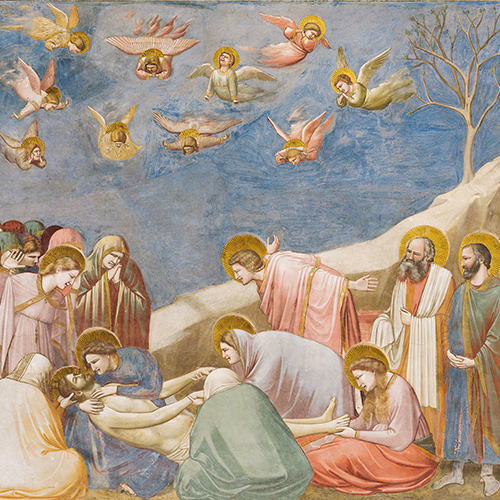
Lamentation by Giotto in Scrovegni Chapel, 1305
During the Italian Renaissance, works of art could serve many different functions. From sacred paintings that celebrated the stories of the life of Christ, to refined portraits of members of the elite, to the funerary monuments of formidable rulers, each of these works was designed to serve a specific purpose and to elicit a certain type of response in its viewers, invoking awe, admiration, praise, devotion, and more. Architectural structures were also designed to convey similar ideas and to shape visitors’ experiences of them.
Art historian Sophia D’Addio of Columbia University offers an introduction to the visual culture of Renaissance Italy from the 14th through 16th centuries in a five-part series of richly illustrated programs on varying types of images, objects, and structures. She examines some of the most influential and fascinating works of the period, exploring their formal innovations and the relationships between powerful patrons and skilled artists that resulted in their creation. Works from both the great centers of artistic production—Florence, Venice, Rome—and the periphery are considered.
April 24 Narrative and Naturalism
The great fresco cycles of Giotto di Bondone, dating to the turn of the 14th century, are celebrated for their burgeoning naturalism—a quality that would reach new heights in the art of the Renaissance. Covering Giotto’s frescoes at Assisi and Padua; those of Masaccio, Domenico Ghirlandaio, and others in Florence; and the paintings of Vittore Carpaccio in Venice, D’Addio traces the development of narrative painting cycles, with particular emphasis on the immersive qualities of these images and the spaces that they decorated.
May 1 The Development of the Altarpiece
An altarpiece is a type of painting or sculptural tableau that serves as a visual support for the celebration of the Mass. It was installed behind the high altar of a church, and the altars of side chapels were adorned with altarpieces as well. Over the course of the Renaissance the form of the altarpiece underwent a stylistic evolution, moving from the great Gothic polyptych (including those by such illustrious artists as Duccio and Paolo Veneziano) to the unified pala, or single-field altarpiece (of which Titian’s Assunta provides one such revolutionary example), and the subjects depicted spanned from the iconic to the narrative.
May 8 Portraiture and the Fashioning of the Self
Renaissance portraits served myriad functions: They were commissioned as diplomatic gifts, to broker marriage contracts, and to commemorate charitable works, among other purposes. Portraits documented and embellished the likenesses of the individuals that they represented and played an essential role in the self-fashioning of artists and patrons alike. D’Addio considers portraits in a variety of media including bronze portrait medals, single-figure painted panels and canvases, and embedded portraits within larger paintings.
May 15 Tomb Monuments: Commemorating the Dead
Although the Renaissance is often associated with a greater interest in the achievements of humanity, it remained a deeply pious era rooted in the Christian faith. Patrons’ aspirations for the afterlife are reflected in the funerary monuments that they commissioned for themselves and their forebears. Often combining multiple artforms including painting, sculpture, and architecture, these monuments also reflected the worldly ambitions of their patrons—and the artists who created them.
May 22 Eloquent Architecture: Sacred Shrines and Civic Strongholds
The relationship between form and function is perhaps most immediately apparent in architectural structures, as their design must both reflect and shape the way in which they were intended to be used. In the design and decoration of churches and cathedrals, government buildings, and palatial residences, the architects of the Renaissance often made stylistic choices that were able to visually convey the functions of their structures and to condition visitors’ experiences of their exterior and interior spaces.
5 sessions
World Art History Certificate core course: Earn 1 credit*
General Information
*Enrolled participants in the World Art History Certificate Program receive 1 core course credit. Not yet enrolled? Learn about the program, its benefits, and how to register here.